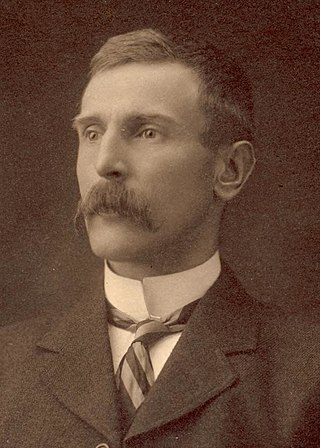
Lieutenant General Sir James Whiteside McCay,, who often spelt his surname M'Cay, was an Australian general and politician.

Jørgen Christian Jensen was a Danish-born Australian recipient of the Victoria Cross, the highest award for gallantry in battle that could be awarded to a member of the Australian armed forces. Jensen emigrated to Australia in 1909, becoming a British subject at Adelaide, South Australia, in 1914. A sailor and labourer before World War I, he enlisted in the Australian Imperial Force (AIF) in March 1915, serving with the 10th Battalion during the latter stages of the Gallipoli campaign. After the Australian force withdrew to Egypt, Jensen was transferred to the newly formed 50th Battalion, and sailed for France with the unit in June 1916. On the Western Front, he was wounded during the battalion's first serious action, the Battle of Mouquet Farm in August, and only returned to his unit in late January 1917. On 2 April, his battalion attacked the Hindenburg Outpost Line at Noreuil, where his actions leading to the capture of over fifty German soldiers resulted in the award of the Victoria Cross.
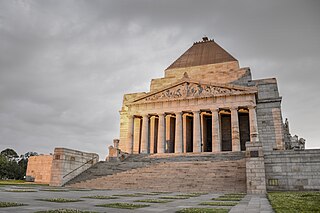
The Shrine of Remembrance is a war memorial in Melbourne, Victoria, Australia, located in Kings Domain on St Kilda Road. It was built to honour the men and women of Victoria who served in World War I, but now functions as a memorial to all Australians who have served in any war. It is a site of annual observances for Anzac Day and Remembrance Day, and is one of the largest war memorials in Australia.
The Official History of Australia in the War of 1914–1918 is a 12-volume series covering Australian involvement in the First World War. The series was edited by C. E. W. Bean, who also wrote six of the volumes and was published between 1920 and 1942. The first seven volumes deal with the Australian Imperial Force while other volumes deal with the Australian Naval and Military Expeditionary Force at Rabaul, the Royal Australian Navy, the Australian Flying Corps and the home front; the final volume is a photographic record.

Phillip Davey, was an Australian recipient of the Victoria Cross (VC), the highest award for gallantry in battle that could be awarded to a member of the Australian armed forces at the time. Davey enlisted in the Australian Imperial Force in December 1914 for service in World War I, and joined his unit, the 10th Battalion, on the island of Lemnos on 10 April 1915. Along with his battalion, he landed at Anzac Cove, Gallipoli, on 25 April. He fought at Anzac until he was evacuated sick in early November, returning to Australia the following January.
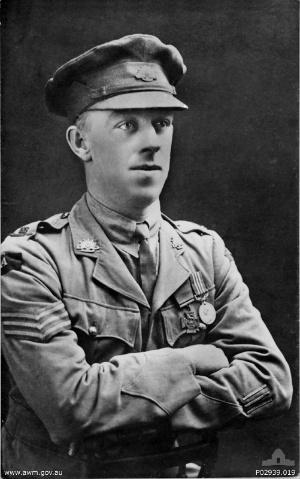
George Julian "Snowy" Howell, VC, MM was an Australian recipient of the Victoria Cross, the highest decoration for gallantry "in the face of the enemy" that can be awarded to members of the British and Commonwealth armed forces. Howell was decorated with the Victoria Cross following his actions during the Second Battle of Bullecourt, in which he ran along the parapet of a trench bombing the German forces attacking his position through the use of grenades, and thus driving them back.

Henry Dalziel, VC was an Australian recipient of the Victoria Cross (VC), the highest award for gallantry in the face of the enemy that can be awarded to British and Commonwealth forces. He was awarded the VC while serving with the Australian Imperial Force during the First World War. Dalziel's VC was the 1,000th awarded. After the war, Dalziel returned to Australia and tried to make a living by farming. Troubled by the injuries he sustained during the war, he left the land and took up factory work. He moved between jobs several times during the 1930s, and led something of a transient lifestyle, even at one stage turning to gold prospecting. In the mid-1930s he rejoined the army in a part-time capacity and during the Second World War served in a training role in Australia. He died in 1965 at the age of 72.
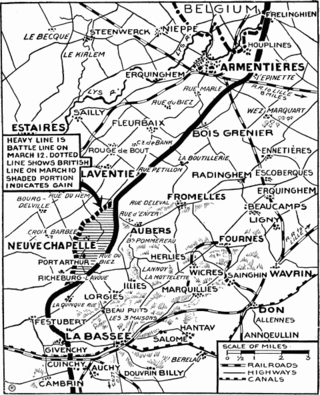
The Attack at Fromelles (French pronunciation:[fʁɔmɛl] 19–20 July 1916, was a military operation on the Western Front during the First World War. The attack was carried out by British and Australian troops and was subsidiary to the Battle of the Somme. General Headquarters of the British Expeditionary Force had ordered the First Army and Second Army to prepare attacks to support the Fourth Army on the Somme, 50 mi to the south, to exploit any weakening of the German defences opposite. The attack took place 9.9 mi from Lille, between the Fauquissart–Trivelet road and Cordonnerie Farm, an area overlooked from Aubers Ridge to the south. The ground was low-lying and much of the defensive fortification by both sides consisted of building breastworks, rather than trenches.
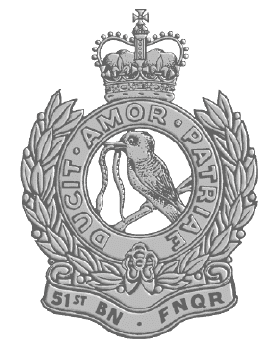
The 51st Battalion, Far North Queensland Regiment is an Australian Army Reserve Regional Force Surveillance Unit headquartered at Porton Barracks in Cairns. The battalion's primary role is to conduct reconnaissance and surveillance tasks in support of border security operations. Its area of operations includes the Torres Strait and the Cape York littoral environment. Additional tasks for 51FNQR include the collection and collation of military geographic information as well as community engagement and disaster relief operations.

The Ploegsteert Memorial to the Missing is a Commonwealth War Graves Commission (CWGC) memorial in Belgium for missing soldiers of World War I. It commemorates men from the Allied Powers who fought on the northern Western Front outside the Ypres Salient and whose graves are unknown. The memorial is located in the village of Ploegsteert and stands in the middle of Berks Cemetery Extension.

Fromelles is a commune in the Nord department in northern France. As of 2019 it had a population of 1,041; its inhabitants are called Fromellois. It is located about 16 kilometres (10 mi) to the west of Lille.

The 57th Battalion was an infantry battalion of the Australian Army. Formed in early 1916 for service during World War I, the battalion served on the Western Front until the end of the war, when it was disbanded. In 1921, it was re-raised as a part-time unit in Victoria, known as "The Merri Regiment". In 1930, the battalion was amalgamated with the 60th Battalion, to form the 57th/60th Battalion, which remained linked until it was disbanded in 1946, after having fought against the Japanese in New Guinea and Bougainville during World War II.

Byaduk is a township in the Shire of Southern Grampians in the Western District of Victoria, Australia. European settlement began around 1853 by Wendish or Sorbian Lutheran immigrants who gave it the name Neukirch after the town in Saxony.

Peter Corlett OAM is an Australian sculptor, known for his full-figure sculptures cast in bronze, especially his memorial works.
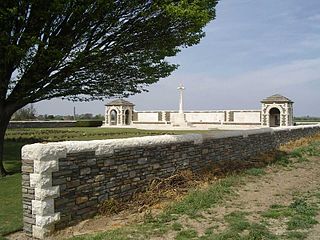
The V.C. Corner Australian Cemetery and Memorial is a Commonwealth War Graves Commission (CWGC) World War I cemetery and memorial. It is in the commune of Fromelles, in the Nord departement of France, about 2 kilometres (1.2 mi) northwest of the village of Fromelles on the D22C road (rue Delval).

Fromelles Military Cemetery is a First World War cemetery built by the Commonwealth War Graves Commission on the outskirts of Fromelles in northern France, near the Belgian border. Constructed between 2009 and 2010, it was the first new Commonwealth War Graves Commission cemetery for more than 50 years, the last such cemeteries having been built after World War II. The cemetery contains the graves of 250 British and Australian soldiers who died on 19 July 1916 in the Battle of Fromelles.

The Le Trou Aid Post Cemetery is a World War I cemetery located in the commune of Fleurbaix, in the Pas-de-Calais departement of France, about 3 kilometres (1.9 mi) south of the village of Fleurbaix on the D175 road.
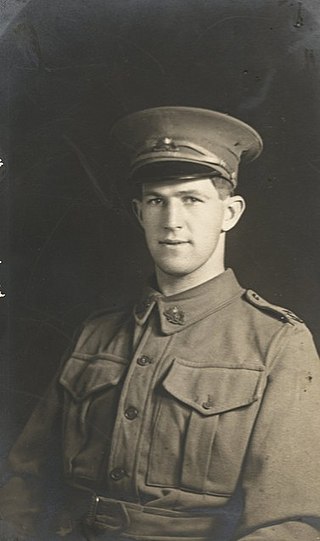
Thornton Gainsborough "Tom" Clarke was an Australian rules footballer who played with Fitzroy in the Victorian Football League (VFL), and the Essendon Association Football Club in the Victorian Football Association (VFA).
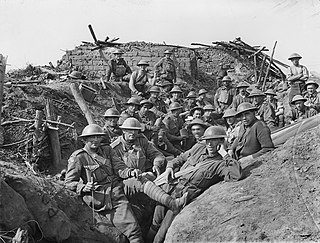
The 50th Battalion was an infantry battalion of the Australian Army. It was originally raised in Egypt in early 1916 for service during World War I, drawing a cadre of experienced personnel from the 10th Battalion. After the unit's formation, it was transferred to Europe where it took part in the fighting in the trenches of the Western Front in France and Belgium. Following the end of hostilities, the battalion was amalgamated with the 51st Battalion in early 1919 as demobilisation reduced the numbers in both battalions. In the inter war period, the battalion was briefly reformed in 1921 as a part-time unit based initially in South Australia and then later in Tasmania. At different periods it was amalgamated with both the 10th and 12th Battalions. The battalion did not see combat during World War II, being employed as garrison troops in Australia instead, and it was disbanded in mid-1945.



















